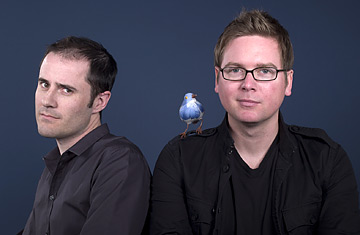
Evan Williams and Biz Stone of Twitter
(2 of 8)
But this event was happening in 2009, so trailing behind the real-time, real-world conversation was an equally real-time conversation on Twitter. At the outset of the conference, our hosts announced that anyone who wanted to post live commentary about the event via Twitter should include the word #hackedu in his 140 characters. In the room, a large display screen showed a running feed of tweets. Then we all started talking, and as we did, a shadow conversation unfolded on the screen: summaries of someone's argument, the occasional joke, suggested links for further reading. At one point, a brief argument flared up between two participants in the room--a tense back-and-forth that transpired silently on the screen as the rest of us conversed in friendly tones.
At first, all these tweets came from inside the room and were created exclusively by conference participants tapping away on their laptops or BlackBerrys. But within half an hour or so, word began to seep out into the Twittersphere that an interesting conversation about the future of schools was happening at #hackedu. A few tweets appeared on the screen from strangers announcing that they were following the #hackedu thread. Then others joined the conversation, adding their observations or proposing topics for further exploration. A few experts grumbled publicly about how they hadn't been invited to the conference. Back in the room, we pulled interesting ideas and questions from the screen and integrated them into our face-to-face conversation.
When the conference wrapped up at the end of the day, there was a public record of hundreds of tweets documenting the conversation. And the conversation continued--if you search Twitter for #hackedu, you'll find dozens of new comments posted over the past few weeks, even though the conference happened in early March.
Injecting Twitter into that conversation fundamentally changed the rules of engagement. It added a second layer of discussion and brought a wider audience into what would have been a private exchange. And it gave the event an afterlife on the Web. Yes, it was built entirely out of 140-character messages, but the sum total of those tweets added up to something truly substantive, like a suspension bridge made of pebbles.
The Super-Fresh Web
